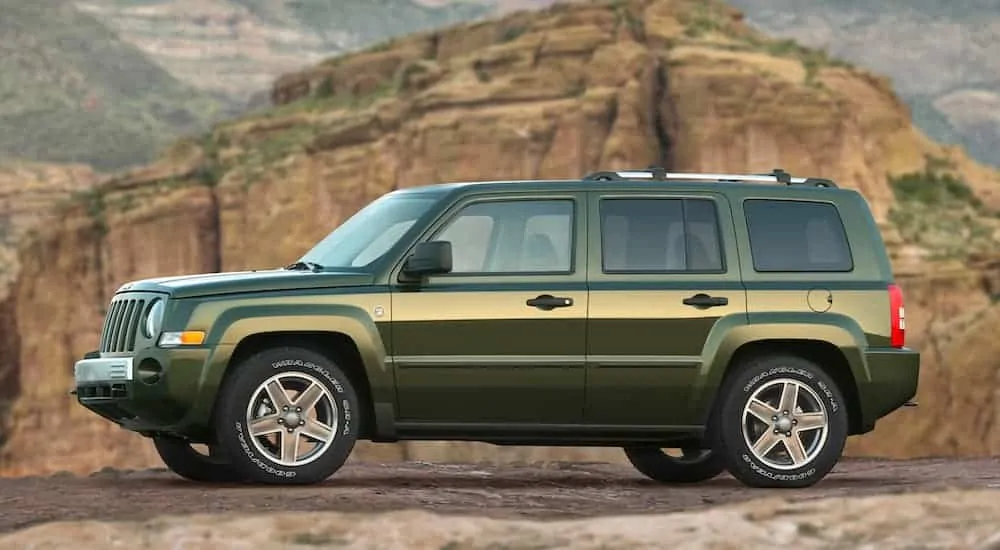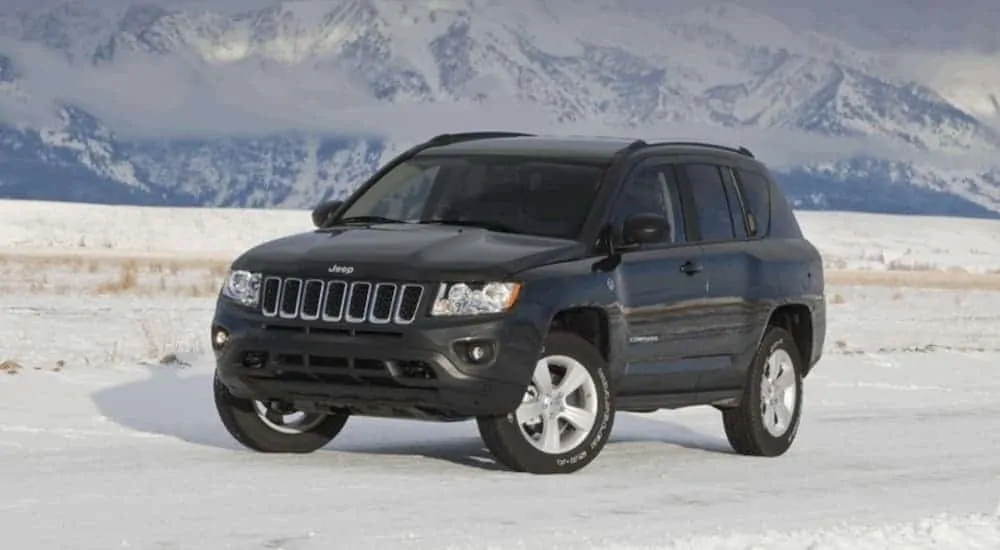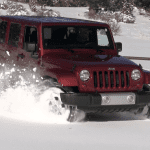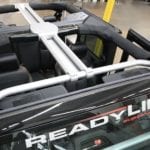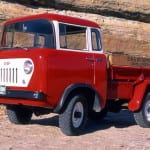A quick look at the new SUVs on the market will quickly reveal how far these vehicles have strayed from their roots. Instead of being built to traverse dirt roads and muddy trails, the newest models are designed for comfort on highways and city streets. If you do want a rugged SUV today, then it is time to start searching for something at a used car dealership. Not only are some of the older SUVs better suited for use as a true sports utility vehicle, but most people will be far happier beating up a $10,000 vehicle on back roads than a $30,000 vehicle. Three good options to consider in that price range are .
While some Jeep purists may look down on the Jeep Compass and Jeep Patriot as not being true off-road Jeeps, if you find one with the right options, then you will be rewarded with a versatile vehicle that can outperform nearly all of its competitors off-road. And if you need something with a little bit more off-road ability, then a Jeep Liberty can fit that bill as one of the few midsize SUVs with a true RWD-based 4WD system.
The Jeep Compass
When it was first introduced for the 2007 model year, the Jeep Compass was a departure from Jeep’s traditional rugged rear-wheel drive vehicles. Offered with front-wheel drive and a continuously variable transmission (CVT), the early Jeep Compass was a vehicle best suited to spending its life on paved roads. However, for the 2011 model year refresh, Jeep returned to its roots and enhanced the off-road capabilities of the Jeep Compass. The 2011 and later vehicles are also preferable because the refresh greatly improved the interior look and feel of the Jeep Compass.
The 2011 Jeep Compass came with two different engine options and three different transmissions. The weaker engine was a 2.0L that produced only 158 hp and 141 lb-ft of torque. Fortunately, this engine is easily avoided as it only came on the base trim in FWD. The other option was a 2.4L with 172 hp and 165 lb-ft of torque. And while this engine is still far from impressive, it will suffice for light off-road use. For transmissions, the options are either a five-speed manual or the CVT. However, the 4WD “trail rated” Freedom Drive II Off-Road package that was introduced for the 2011 model year came with a modified version of the CVT that included a low range for improved off-road performance.
Even if you prefer to drive a manual (which is probably the better option for the Jeep Compass), then scouring the lots of used car dealerships for a vehicle with the Off-Road package is still a good idea because that package also came with a large number of highly desirable utility features. These included hill descent and ascent control, an engine oil cooler, skid plates, tow hooks, and 17” alloy wheels. All together, these features make the Jeep Compass a surprisingly solid choice for light off-road use despite its less than ideal powertrain. But if you just want to be able to drive dirt roads and handle bad weather, then you will probably be more than happy with the standard Freedom Drive I 4WD system available on the Jeep Compass.
The first generation of the Jeep Compass was produced for over a decade before being replaced by the second generation of the vehicle for the 2018 model year. This makes them a common sight at used car dealerships, and older examples in good condition are readily available for under $10,000. This long production run also means that both factory and aftermarket parts are also widely available for the Jeep Compass, allowing you to keep an older vehicle running or customize your vehicle to further improve its performance.
The Jeep Patriot
Introduced for the same 2007 model year as the Jeep Compass, the Jeep Patriot was the second of Jeep’s FWD crossover SUVs. Mechanically, the Jeep Patriot is virtually identical to the Jeep Compass and offers the same engine and drivetrain options. The two are also very similar dimensionally, although the Jeep Patriot is a touch larger and heavier with slightly more ground clearance and cargo space. In general, these two vehicles can almost be considered different trims of the same vehicle, with the Patriot being a little cheaper and more off-road oriented while the Compass had more mainstream looks and some additional luxury features.
However, there are some relevant mechanical differences that favor the Jeep Patriot. First, the Jeep Patriot offered the Freedom Drive II package from its introduction in 2007, making it possible to find an older off-road equipped example at an extremely low price. Second, if you do not want to drive a manual but cannot stand the CVT, Jeep Patriots from the 2014 model year and later had the option of a traditional six-speed automatic transmission. Although finding a Jeep Patriot with this option might take a bit of time searching used car dealership inventories.
Ultimately, the Jeep Patriot and the Jeep Compass are similar enough that they can be treated virtually interchangeably and if you find one in good condition with the right features, it is probably not worth getting hung up on which model it is––unless, of course, you absolutely cannot stand the looks of one of them.
The Jeep Liberty
The third good option for a used Jeep is the Jeep Liberty. Marketed as the Jeep Cherokee outside of the United States, the second-generation Jeep Liberty ran from the 2008 to the 2012 model years before being replaced by an all-new Jeep Cherokee that shared little more than the name. While this means that shopping used car dealerships for a Jeep Liberty will probably have you looking at older vehicles than if you search for a Jeep Compass or Jeep Patriot, the RWD design and 3.7L V6 engine of the Jeep Liberty gives it far better performance and makes it one of the best true off-road SUVs.
Dimensionally, the Jeep Liberty is only slightly larger than the Jeep Patriot, but because of its more rugged construction, it weighs considerably more. However, with 210 hp and 235 lb-ft of torque from its V6 engine, you probably will never notice the added bulk of the Jeep Liberty. Unfortunately, the available transmissions for the Jeep Liberty are not as good. While a six-speed manual was originally available, this option was dropped after the first generation, leaving only an antiquated four-speed automatic. But while only having four gears will give you poor fuel economy on the highway, it still makes a better choice for off-road driving than the CVT in the Jeep Compass and Jeep Patriot.
The two different 4WD systems that were offered on the Jeep Liberty are also excellent, but you need to know which one you are getting. The Selec-Trac II is a full-time 4WD system that will kick in when more traction is needed or can be manually locked into 4WD mode. This version of the Jeep Liberty is your best choice if you mainly want a system for driving on paved roads in bad weather, but which can handle off-roading if needed. In contrast, the part-time Command-Trac II system is a traditional 4WD system that must be manually engaged to send power to all four wheels and which is not recommended for use on paved roads or at higher speeds. However, the Command-Trac II offers superior off-road performance and is the better choice for wilderness adventures.
Purchase A Used Jeep
While none of these three Jeep SUVs will perhaps live up to the reputation and off-road capability of the classic Jeep Wrangler, all of them will still give you more fun and utility than the vast majority of newer SUVs. And it does not hurt that a Jeep Compass, Jeep Patriot, or Jeep Liberty will also be significantly cheaper than a Jeep Wrangler of similar age and mileage. So if you are tired of the luxurious SUVs that make up most of today’s market, head out to a used car dealer and start looking at older Jeeps.
